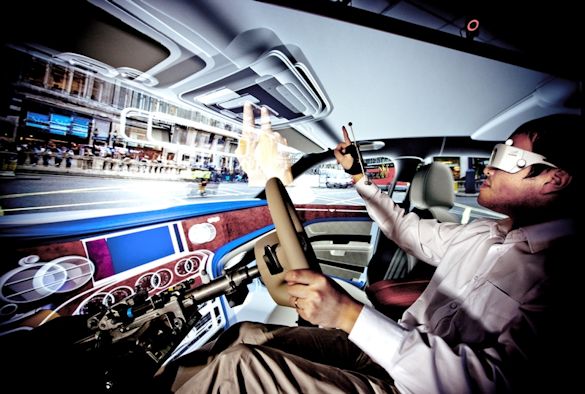
An interdisciplinary research team of University Psychologists and Engineers won the ‘Best Paper Award’ at the 2015 European Virtual Reality conference (EuroVR) in Lecco, Italy.
The paper `The Effects of Multisensory Cues on the Sense of Presence and Task Performance in a Virtual Reality Environment’ explored how signals in multiple modalities, such as vision, touch and hearing can be used to enhance productivity and user experience in Virtual Reality Learning Systems.
Study
In the experimental study, which was undertaken in collaboration with the University’s Virtual Engineering Centre (VEC), participants were asked to change the wheel of a virtual racing car against the clock.
They had to remove the bolts, using a power tool, change the wheel and refasten the bolts. The simulation was augmented with additional visual, auditory and haptic information: The wheel and individual bolts that had to be removed, for example, changed colour to represent that they were properly seated, information that would be provided by haptic information in real life.
Objective measures show that this augmented reality enhances performance. It also leads to higher subjective ratings for ‘presence’, the sense of being part of the virtual world.
The paper was presented by Natalia Cooper, an ESRC Case funded PhD student, who is jointly supervised by Dr Georg Meyer from the Department of Psychological Sciences and Dr Mark White from the School of Engineering.
Natalia was awarded first prize in the University’s Faculty of Health and Life Sciences Online Poster Day with an entry on the same topic earlier this year.
Highly realistic
Dr Gillian Murray, from the University’s Virtual Engineering Centre (VEC), said: “Current VR systems are brilliant at creating highly realistic three dimensional visual worlds, and the VEC, in collaboration with companies such as Virtalis and Optis, is at the forefront of this work.
“Some aspects of real environments, however, are very difficult to create in VR. It is, for example, technically very demanding to create the feeling of touch (haptics). Our research shows that alternative signals can effectively augment virtual reality simulations.”
The project used the VR facilities and expertise at Daresbury and was linked to Project STRIVE (Simulation Tools for Rapid Innovation in Vehicle Manufacture) which aims to develop a new digital supply chain to support advanced engineering companies improve manufacturing processes with partners such as Bentley Motors, Optis and DNA Agile (Valuechain.com).
Bentley Motors
Senga Shufflebotham, from Bentley Motors, added: “As part of the STRIVE project, the Bentley team has participated in the research activities related to this study. The findings will be invaluable to the team.”
Psychologist, Dr Georg Meyer, said “This is an excellent demonstration how expertise from Engineering and Psychology can be very effectively combined to exploit the fantastic facilities we have at Liverpool and to make a real impact. The access we had to the VEC facilities, expertise and commercial links via the ‘VEC sandpit’ is fantastic. “
Dr Ferdinando Milella, from the Virtual Engineering Centre, added: “The work is highly relevant because it paves the way for a correct and efficient use of Immersive Virtual Environments in simulating and assessing human-centred procedures, in manufacturing as well as in other areas, for both training and feasibility studies“
Liverpool Engineer, Dr Mark White, commented: “The results directly extend to other areas where professionals are trained in simulated environments, such as flight simulation or medical applications.”
Note:
STRIVE is a £3.3million collaborative industrial research and development project, part funded by the department for Business, Innovation and Skills Advanced Manufacturing Supply Chain Initiative (AMSCI).

